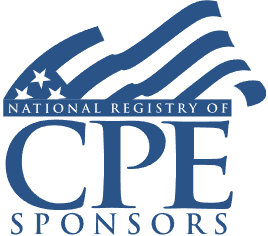Calculating S Corp Stock and Debt Basis: Avoiding Loss Limitations and Excess Distributions

Course Details
- smart_display Format
On-Demand
- signal_cellular_alt Difficulty Level
Intermediate
- work Practice Area
Tax Preparer
- event Date
Friday, May 17, 2024
- schedule Time
1:00 p.m. ET./10:00 a.m. PT
- timer Program Length
110 minutes
-
BARBRI is a NASBA CPE sponsor and this 110-minute webinar is accredited for 2.0 CPE credits.
-
BARBRI is an IRS-approved continuing education provider offering certified courses for Enrolled Agents (EA) and Tax Return Preparers (RTRP).
This course will provide tax professionals and advisers with the tools and understanding to correctly calculate S corporation shareholders' stock and debt basis and advise clients to avoid adverse tax consequences due to loss limitations or excess distributions.
Faculty

Mr. Barnett’s practice is highly concentrated in the areas of taxation, trusts, estates, corporate and partnership law and charitable planning. His experience includes surrogate’s court practice, tax dispute resolution in both federal and state jurisdictions, and tax court representation. Mr. Barnett frequently assists clients in structuring financial transactions and charitable gifts. His articles and lectures encompass a wide variety of topics, including business succession, estate planning, generation-skipping, stock options, effective strategies for removing tax liens, proper utilization of the marital deduction and utilization of partnership elections.

Ms. Schaefer is a principal in Clark Nuber’s tax group, she works closely with her clients to develop creative tax strategies for many types of businesses; especially with manufacturing, distribution, construction and professional service companies. Ms. Schaefer has more than 30 years of experience working with both private and public companies, she has the proven expertise to help clients grow and succeed. Prior to joining Clark Nuber, Ms. Schaefer worked with SVA Certified Public Accountants, S.C. for 16 years.
Description
Calculating basis for S corporation shareholders is a time-consuming exercise for tax professionals. Accurately calculating basis is critical to determine how much a shareholder can withdraw in distributions without recognizing taxable income. When a shareholder takes distributions exceeding his basis, the excess distribution is taxable as a capital gain.
Tracking basis is also essential in determining whether shareholders can deduct S corporation losses on their personal returns. Available losses are limited to basis and specific ordering rules govern how basis is utilized.
Form 7203, S Corporation Shareholder Stock and Debt Basis Limitations, now replaces the varying basis schedules included in tax returns by tax practitioners and aids the IRS in examining basis and debt discrepancies.
Listen as our experienced panel of tax professionals provides a detailed roadmap of calculating stock basis, debt basis, and the interrelation of distributions to basis, as well as best practices to help S corporation shareholders avoid unnecessary tax.
Outline
- Mechanics of calculating stock basis
- Items that increase stock basis
- Items that decrease stock basis
- Ordering rules
- Tracking basis against distributions to avoid current double taxation
- Preparing Form 7203
- Loss limitation rules
- Debt basis rules and calculations
- Basis strategies for end of business
Benefits
The panel will review these and other key issues:
- Calculating and maintaining accurate S corp stock and debt basis
- Understanding basis items specific to S corporations
- Applying loss limitation rules
- Preparing form Form 7203, S Corporation Shareholder Stock and Debt Basis Limitations
- Calculating basis with a view toward sale, liquidation, or redemption
NASBA Details
Learning Objectives
Upon completing this webinar, you will be able to:
- Determine the correct calculation of S corporation shareholders' stock and debt basis
- Discern how much a shareholder can withdraw without recognizing taxable income
- Distinguish items that increase or decrease a shareholder's tax basis
- Verify that debt basis is tracked according to the debt basis rules
- Establish that basis is tracked against distributions to avoid double taxation
- Field of Study: Taxes
- Level of Knowledge: Intermediate
- Advance Preparation: None
- Teaching Method: Seminar/Lecture
- Delivery Method: Group-Internet (via computer)
- Attendance Monitoring Method: Attendance is monitored electronically via a participant's PIN and through a series of attendance verification prompts displayed throughout the program
- Prerequisite: Three years+ business or public firm experience at mid-level within the organization, preparing complex tax forms and schedules, supervising other preparers/accountants. Specific and detailed knowledge and understanding of S corporation stock basis rules, S corporation ownership structure, operating agreements and distributions; familiarity with the rules governing Accumulated Adjustment Accounts (AAA), and difference in treatment of debt between partnerships and S corporations; and basis calculations for S corporation shareholders according to IRC sections 1366 and 1367.

Strafford Publications, Inc. is registered with the National Association of State Boards of Accountancy (NASBA) as a sponsor of continuing professional education on the National Registry of CPE Sponsors. State boards of Accountancy have final authority on the acceptance of individual courses for CPE Credits. Complaints regarding registered sponsons may be submitted to NASBA through its website: www.nasbaregistry.org.

Strafford is an IRS-approved continuing education provider offering certified courses for Enrolled Agents (EA) and Tax Return Preparers (RTRP).
Related Courses

Family Partnerships: Navigating the Discounting Rules for Family-Controlled Entities
Thursday, March 6, 2025
1:00 p.m. ET./10:00 a.m. PT

Form 1041 Schedule D: Reporting Capital Gains for Trusts and Estates
Available On-Demand

Closer Connection Exception: Determining Tax Home; Treaty Tie-Breakers, Form 8840
Thursday, April 10, 2025
1:00 PM E.T.
Recommended Resources
How CPE Can Bridge the Gap Between What You Know and What You Need to Know
- Career Advancement